
The quality of a software product is always a priority for business and not an option. Therefore, when a business is considering maintenance, you should implement the best software testing strategies An emphasis on quality and performance brings software testing services into focus for many companies. There are multiple types of software testing such as agile testing, automation testing, unit testing, usability testing, acceptance testing, security testing, sanity testing, smoke testing, compatibility testing, ad hoc testing, integration testing, performance testing, etc.
1. Types of Software Testing
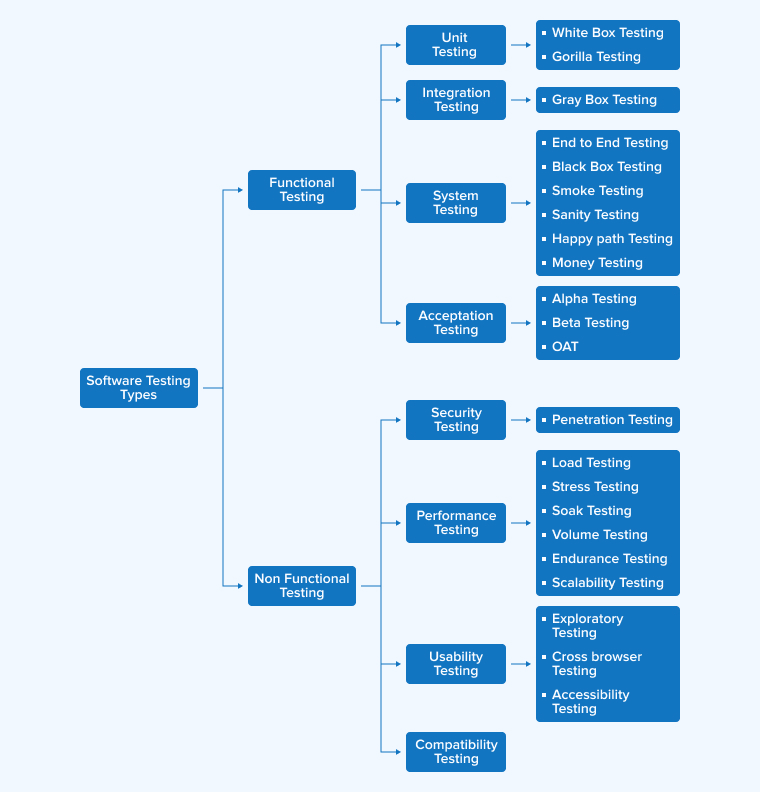
It is time to explore all types of software testing and get to know which one will help us resolve which type of flaws. Software testing is categorized into two types functional testing and non-functional testing. So, let’s understand each of them in detail.
1.1 Functional Testing
Functional testing ensures that a software application’s functionalities are as specified in the requirements. The key aspect of functional testing is that it does not rely on the application’s source code. You can check the User Interface, Database, APIs, and Client/Server applications, as well as the security and functioning of the program through a series of tests, and verify if all options are available or not. You can do Functional testing either manually or with the help of automation tools.
Benefits of Functional Testing
Functional testing provides the following benefits:
- Detecting application functioning issues at an early stage is crucial to prevent them from becoming significant problems.
- Conducting tests to confirm the proper functioning of essential elements and assessing the system’s capacity to manage unforeseen circumstances.
- Ensuring the software programs fulfill the requirements of end users and are free of bugs.
- Conducting thorough and efficient testing of software applications across different situations and scenarios.
- Supervising the advancement and modifying the testing strategies as necessary.
1.2 Non-Functional Testing
Non-functional testing focuses on examining the application’s non-functional characteristics, such as performance, usability, and dependability among others. You can perform tests in this section that influence the performance of the application. There are multiple ways to analyze the non-functional aspects of business apps through software testing.
The initial black box testing and white box testing also had these functional tests. The perception of ways are different but it has the same goal of making applications bug-free and high-performing. Let’s get into the details to understand each type of software testing.
Benefits of Non-Functional Testing
Non-functional testing provides the following benefits:
- Enhancing security measures to protect systems from cyber attacks.
- Ensuring the system’s capacity to handle multiple user requests simultaneously without affecting the performance.
- Contributing to improving the overall efficiency of the system.
Let’s understand the different types of functional and non‑functional testing in detail, starting with functional testing.
2. Types of Functional Testing
Let’s discuss different tests used to verify the software’s functionality.
2.1 Unit Testing
Unit tests are done in many steps as rightly highlighted in the tweet below. It is one of the most important types of software testing.
As a developer, you write code. Unit testing is the software development practice of writing additional code, called unit tests. Learn why testing helps you create better software and how to run various unit tests. https://t.co/PQ4mCeTbxH pic.twitter.com/6BYmCYIKIt
— Trailhead (@trailhead) September 23, 2019
In unit testing, individual units or software components are tested. In this type of software testing, each unit is minutely observed and analyzed. The goal of Unit Testing is to ensure that each software component works as intended. A unit is the smallest element of software that needs testing. It generally just has one or a few inputs and one output.
Programmers/ developers carry out this process and, not the testers. Because it involves retesting every code, which would be duplicated if testers do that. Hence, developers perform this type of unit testing.
Example of Unit Testing- Python unit test – unit test example
Benefits of Unit Testing
Below are some of the benefits of Unit Testing:
- Identifying problems early in the development process is beneficial as it prevents them from becoming more challenging and costly to fix.
- It aids in ensuring that modifications to the code do not generate more errors.
- It enhances the modularity and facilitates understanding and maintenance of the code.
- It enhances the overall quality and reliability of the program.
2.2 Integration Testing
In integration testing, individual components are integrated and tested as a group. This level of testing is designed to reveal flaws in the interaction among integrated units.
There are different ways of approaching the integration tests of your software development lifecycle, such as the top-down approach, Big Bang approach, or Sandwich/hybrid.
Integration testing example from Simplilearn
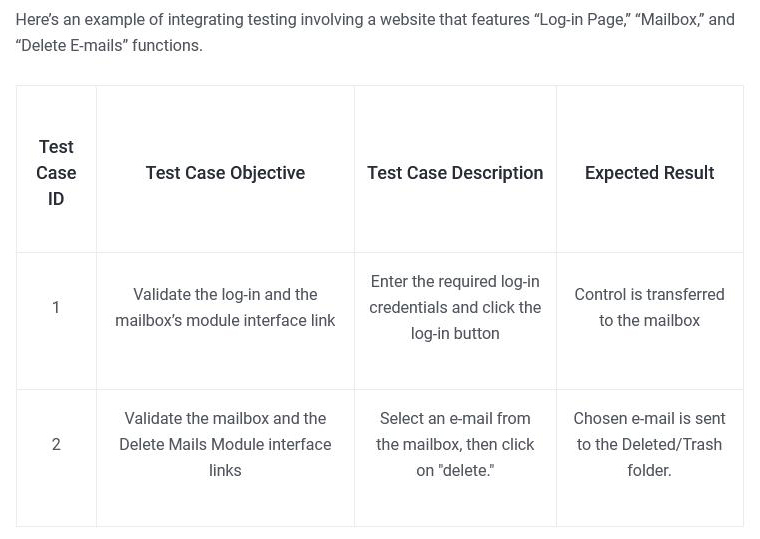
Benefits of Integration Testing
Below are some of the benefits of Integration Testing:
- Top-down integration testing involves starting with the most superior-level modules and distinguishing them from the subordinate-level modules.
- Bottom-up integration testing involves the sequential integration of lower-level modules with higher-level components.
- Big-bang integration testing is a method that involves the simultaneous combination and integration of all components.
- Incremental integration testing is a method that involves integrating modules into small groups and evaluating each group as it is introduced.
2.3 System Testing
In the software testing process, system testing has an important role to play. It is about checking whether the system meets the required standards by performing end-to-end testing involving system plans, system test cases, and system tests. You can use different types of testing tools and methodologies to test the system and conduct functional testing.
Here is an example of system testing from Quora:
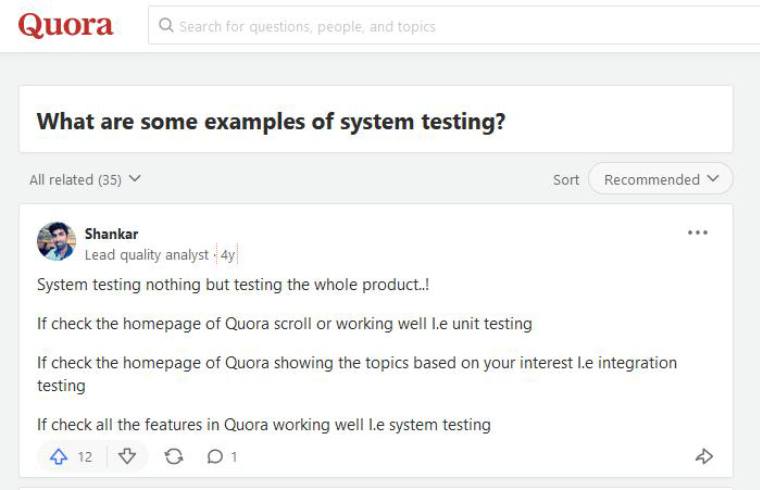
Benefits of System Testing
Below are some of the benefits of System Testing:
- The testers do not need additional programming skills to run this test.
- It tests the complete product or program to identify any flaws or problems that may have been missed during unit testing and integration testing.
- The testing environment closely resembles the actual production or commercial environment.
- It thoroughly assesses the system’s performance using various test scenarios, ensuring that it meets both the technical and business needs of clients.
2.4 Interface Testing
As rightly said in this tweet, User interface testing sets the ground for usability on your websites, web apps, and mobile applications.
User interface testing sets the ground for usability on your websites, web apps, and mobile applications.
— BrowserStack (@browserstack) August 25, 2022
Learn how 👉 https://t.co/VofEeb088m pic.twitter.com/yAyupkcHXa
The Interface is the platform that connects the back-end functionality with the front-end of an application. You can test the app UI during user interface testing. The purpose of user interface testing is to ensure that the UI is designed as per the documented requirements When you see an application running successfully with great UIs, the reason behind it is strong interface testing that has made the application robust and secure to perform in any environment.
Benefits of Interface Testing
Below are some of the benefits of Interface Testing:
- A user-friendly and intuitive UI reduces the software learning curve. Interface testing enhances the market appeal of the app due to its elegant design and user-friendly GUI.
- Interface testing provides a better understanding of user expectations and allows suitable modifications to the interface. As a result, this test helps improve customer satisfaction and creates a more effective application with the potential to attract a larger user base.
2.5 Regression Testing

After each modification, developers have to use Regression testing to determine the stability and functionality of the software. Regression testing ensures that a software update does not impact the existing product functionalities. Regression testing allows developers to run tests until the application is bug-free. Regression testing involves various software testing techniques such as ‘retest all’, which includes retesting the entire app until it is error-free. During the execution of Regression testing, test case prioritization is based on factors like priority, criticality, and its impact on the app development. After this step, you can ensure that the developed app is all set to enter the market. Now at this point majorly, all the tests are completed and all the errors are addressed.
Example – Regression Test Example
Benefits of Regression Testing
Below are some of the benefits of Regression Testing:
- It guarantees that no additional errors have been created following the integration of new features into the system.
- Regression Testing often involves selecting test cases from the current test suite, as we are already aware of their expected results. Therefore, it can be easily mechanized using automated techniques.
- It helps in protecting the quality of the source code.
2.6 User Acceptance Testing
Acceptance Testing is a type of software testing that examines the acceptability of a system. The goal of this test is to determine whether the system fulfills the business requirements and whether it is suitable for delivery. User Acceptance Testing determines whether or not the software can be accepted by ensuring that it fulfills all of the client’s criteria and if it is not then it is sent back to the developers to check the requirement sheet and make sure you meet the unmet requirements. Later, it will again undergo the same regression testing to make sure everything is in place.
Example – https://usersnap.com/blog/user-acceptance-testing-example/
Benefits of Acceptance Testing
Below are some of the benefits of Acceptance testing:
- Acceptance testing requires the active involvement of end-users or clients who provide feedback based on their practical usage experience.
- It helps in identifying errors, inconsistencies, or deviations from the requirements that may have gone unnoticed in previous testing stages.
- By identifying and resolving issues during the acceptance testing phase, businesses can significantly reduce the expenses and effort required to rectify problems once the app is in operation.
2.7 Alpha Testing
Alpha testing is a type of testing that looks for all of the software’s faults. You can conduct this test towards the end of the app development process, before the product launch or delivery to the client, to ensure that the user/client receives an error-free software program. Alpha testing comes before beta testing, therefore you’ll need to conduct beta testing after completing alpha testing. Alpha testing is not conducted in a live testing environment. Instead, conduct these assessments in a virtual environment that closely matches the actual world.
Here is an image showing the 7 criteria to start Alpha Testing:
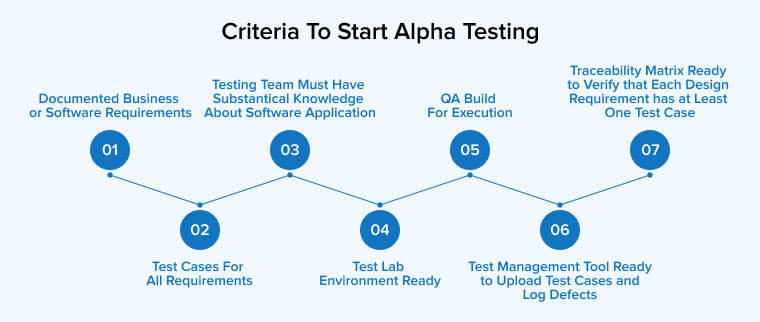
Benefits of Alpha Testing
Below are some of the benefits of Alpha Testing:
- Timely identification of vulnerabilities.
- Improved user experience.
- Internal customers’ feedback.
2.8 Beta Testing
This test is conducted with a small number of actual customers or users in a real-world setting to ensure that the program is error-free and runs smoothly. You can make improvements to the software after gathering input and constructive criticism from those users.
Here is an image showing the 5 criteria to start Beta Testing:

Benefits of Beta testing
Below are some of the benefits of Beta Testing:
- Beta testing allows developers to acquire a deeper understanding of user interactions with the product.
- It enables customers to approve of the product at an early stage, creating a sense of exclusivity and generating excitement about the product.
- This testing facilitates comprehensive bug identification and correction of issues. By engaging a diverse set of beta testers, developers can detect various software defects and rectify them before the product’s release to the general public.
3. Types of Non-Functional Testing
The fundamentals of software testing remain unchanged, and some businesses consider functional testing as well as non-functional testing equally important. We have already explored how functional testing works and what its different types are. Now, when it comes to non-functional testing, its primary function is to test the applications based on load, and how they perform in terms of performance, reliability, usability, and scalability among other things. Non-functional testing such as load and stress testing is commonly performed with the use of test automation tools and solutions like LoadView.
3.1 Documentation Testing
A document is prepared to ensure a smooth software testing process. This documentation aids in estimating testing = coverage and efforts effectively. The test strategy, test cases, and requirements section are all included in the software documentation. Check if almost all types of documents, examples, methods, and samples used in the document are legit or not. If not, modify and correct them.
Here’s a schema implementation in the functional-style JSON API endpoint.
Here’s an functional-style JSON API endpoint in a Rails app. The schemas do lots: input validation/coercion, auto-generating Swagger documentation, testing response bodies in specs, descriptive errors in test/prod. DHH would probably hate it, but I think it’s working well. pic.twitter.com/sy7Ukp7moZ
— Tom Dalling (@tom_dalling) April 17, 2019
Example – Documentation Testing Example
Benefits of Documentation Testing
Below are some of the benefits of Documentation Testing:
- By outlining specific steps to take and giving thorough instructions, test documentation helps testing teams stay calm and collected during the testing process.
- All of the modifications to your program, along with the resulting errors, are documented for your reference.
- With access to thorough test documentation, new team members can quickly become familiar with the testing process.
3.2 Installation Testing
In the software business, installation testing is a form of quality assurance work. The major focus of installation testing is on what consumers will need to do during software installation and setup. It could be anything from a third-party backup app, link description, or any other essential needs. Full, partial, or upgrade types of install/uninstall operations may be part of the testing process. This is a non-functional need but without this, the installation process won’t succeed.
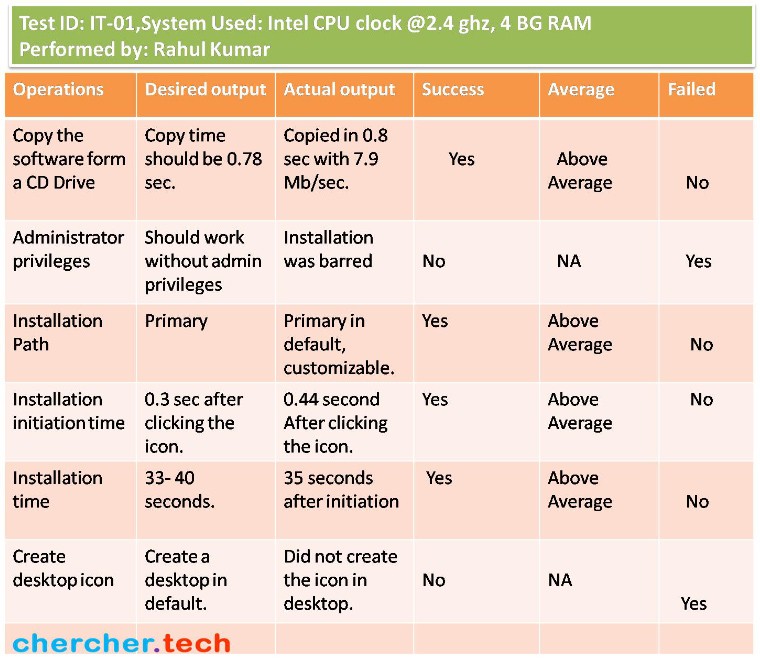
All you need to consider when designing an installation procedure are the path to install the full version of an application, automate testing efforts, manage disk space, set up a distributed testing environment, validate other registry changes after installation, and conduct uninstallation testing.
Example – Installer Testing Example
Benefits of Installation Testing
Below are some of the benefits of Installation Testing:
- By finding and fixing installation flaws and mistakes, installation testing improves the software’s overall quality. This lessens the possibility of negative feedback and user experiences, which might damage the software’s credibility.
- To make sure the software is installed and configured appropriately, installation testing is done. This way, users may install the app without any problems. Customers are more satisfied and have a better overall experience as a result.
- Installation testing lowers the requirement for support services and their costs by finding and correcting installation errors. A lot of time and money can be saved if this happens.
3.3 Performance Testing
Performance testing determines whether the program is performing well as per the expectations. There are performance testing tools that assess the performance of your app and identify areas of concern. You may improve the performance of your software program by addressing these concerns.
The general objective of this performance testing is to compare an application’s performance to different operating systems and network benchmarks such as CPU utilization, page load speed, peak traffic handling, server resource consumption, and so on. There are numerous different forms of performance testing, such as load testing and stress testing. Following are the 4 essential types of performance testing.
Example – TatvaSoft Performance Testing Example
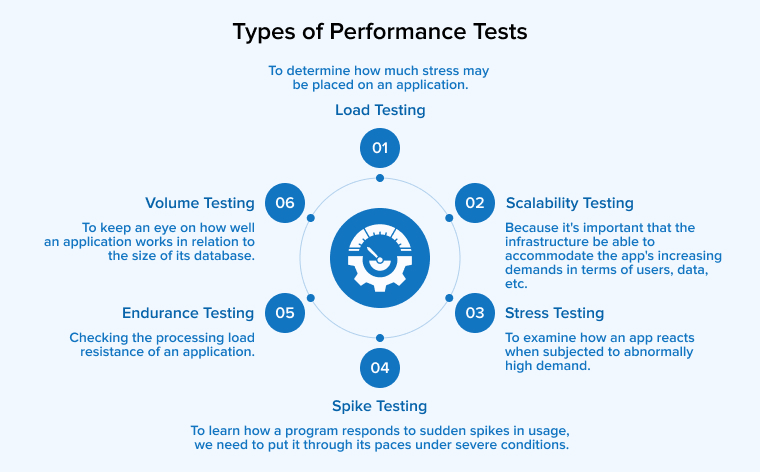
Benefits of Performance Testing
Below are some of the benefits of performance Testing:
- Performance testing verifies the system’s accuracy, speed, load capacity, and other functions.
- If problems arise, it finds them, keeps an eye on them, and fixes them.
- It assures the program is well-optimized and also lets several users utilize it simultaneously.
3.3.1 Load Testing
Load testing is a type of performance testing that assesses the amount of load a system can handle before its performance degrades. You can determine a system’s load capacity by performing load testing.
If your developed application can handle the targeted audiences at a single time then the load test is successful. Unit tests are conducted to determine the load on each feature and how to address any issues to ensure smooth performance.
3.3.2 Stress Testing
Stress is another type of performance testing that ensures the maximum limit of load that can be applied on a website or application. This type of software testing ensures the feasibility of the application, website, or any software and identifies how potential issues can be addressed.
3.3.3 Endurance Testing
This type of testing is continuous testing that measures a specific type of workload consistently applied on the website. Based on this, you can estimate the number of users and concurrent users using these apps.
3.3.4 Spike Testing
For specific business scenarios where there is an unexpected user intervention or load applied to the application, this is a precautionary measure to understand how the app reacts when the load is low.
3.4 Reliability Testing
Reliability testing ensures that the product is free of flaws and able to perform its intended function. It involves testing an application to identify any flaws before deploying it. Each function in the software should be run at least once as part of the feature test. In addition, there should be less interaction between two or more functions during testing. During the reliability test, you can conduct regression tests whenever new functionality is added or old functionality is removed. This ensures that no new issues are introduced into the system.
Before setting the reliability testing objectives, you must mark certain restrictions, such as the software’s behavior under specific testing environments, achievable targets, and time constraints.
Benefits of Reliability Testing
Below are some of the benefits of Reliability Testing:
- If the software has issues that might cause it to malfunction, reliability testing can find them and correct them. Ultimately, this improves the software and makes it more trustworthy for customers.
- It mitigates the likelihood of software malfunctions in production. Businesses and organizations can suffer serious financial and reputational losses in the event of software failure, thus reliability testing is crucial.
- Trustworthy software is more likely to meet consumers’ requirements and exceed their expectations. Customer happiness and loyalty can be enhanced in this way.
3.5 Security Testing
As a software testing practice, it is essential to prioritize security tests. There are multiple ways you can maintain the security of the application. Security testing is a type of software testing that ensures an organization’s systems and applications are free of flaws. The goal of security testing is to identify any system flaws that might lead to data loss or a bad market reputation.
Benefits of Security Testing
Below are some of the benefits of Security Testing:
- By checking for things like weak passwords, unpatched software, and incorrectly installed systems, security testing helps find potential weak spots that hackers may exploit.
- By locating and repairing security holes, it helps strengthen the system’s defenses.
- It verifies that the system satisfies all applicable security requirements and standards, including SOC2, PCI DSS, and HIPAA.
4. Other Aspects of Manual Testing Vs Automated Testing
Manual or Automated- both these types of software testing just define the speed and the precision at which the testing is conducted. As simple as it sounds, there are so many different aspects that make both these types of software testing different from each other.
4.1 Manual Testing
Manual testing is performed by a testing team by exploring and interacting with the developed application. The tester gets a chance to interact with software, APIs, and all other necessary functions where flaws can be identified and resolved. You can use appropriate tools that will help you identify the bugs easily and at an early stage.
This method seems to be tedious and expensive too. If the project is larger, you might need to add more resources, and spending on infrastructure, hiring, and training costs are additional expenses. As this requires a proper setup, it is quite obvious to make human mistakes which might later affect the overall output of the app.
Example – Manual Testing Example
4.2 Automated Testing
The concept of automated testing was brought into the picture to level up the game of manual testing. How to improve your manual testing skills is not the question here, the primary aspect here is understanding how automation and automated testing work. Automated testing is carried out by a machine that runs a pre-programmed test script. The complexity of these tests might range from checking a single method in a class to ensuring that completing a sequence of complex actions in the UI produces the same results.
Automated testing uses programs to run and check the errors in the software or developed app. The efficiency and the speed are unquestionable. While automated testing is more robust and dependable than manual tests, the quality of your automated tests depends on how well your test scripts are written.
Example – Automated Testing Example
5. Exploratory Testing
This type of software testing might sound new to many but this has been around for years. This “after testing” method is used to explore more features using testing. However, more features and enhancements can be analyzed using “Exploratory testing”. You can add this testing to your code, the more testing you’ll need to do to ensure that everything functions properly.
This will also help developers to take pre-steps for each bug you repair, and double-check if that is done or needs any reappear in later releases. Automation is essential to making this happen and creating tests will eventually become a part of your development workflow.
The question is whether manual testing is still worthwhile. The simple answer is yes, and it should be focused on exploratory testing, which seeks to find non-obvious mistakes. An exploratory testing session should not last more than two hours and should have a clear scope to assist testers in focusing on a specific topic.
Example – Exploratory Testing Example
6. Conclusion
This extensive blog highlights all types of software testing you need for any business. May it be any industry or sector, these are the major types of testing that will help you create a bug-free, performing, and top-notch application. We have put forward all the essential points that will help you use these in software development and testing techniques and practically apply them. Your app is different so the testing needs will be different but don’t consider testing an option just because the process is not the same for all. Testing is a necessity to lead a successful app.



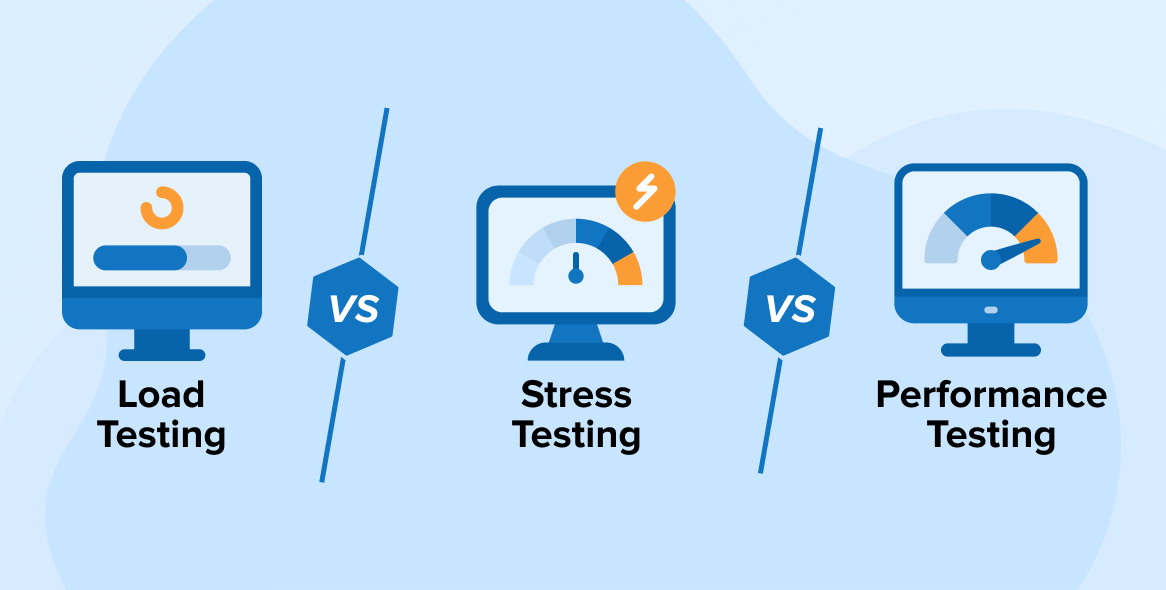


Software testing is the most important part of the software development life cycle. there are several types of software testing that ensure the software quality standards. Here mentioned each testing types perform different roles in the software testing life cycle. Looking forward to more of this type of informative article.
Different type of testing, from functional to performance, security, and usability tests, is essential to making sure the software is stable, bug-free, and easy to use. The development process may be improved by including several testing kinds to produce high-quality software that meets user expectations. Thank you for sharing useful insights on types of software testing.
I appreciate the explanation of the types of software testing. This article also contains helpful links to other resources, which is great for better understanding. If you are looking for better resources to learn about the types of software testing, this article is great for you.